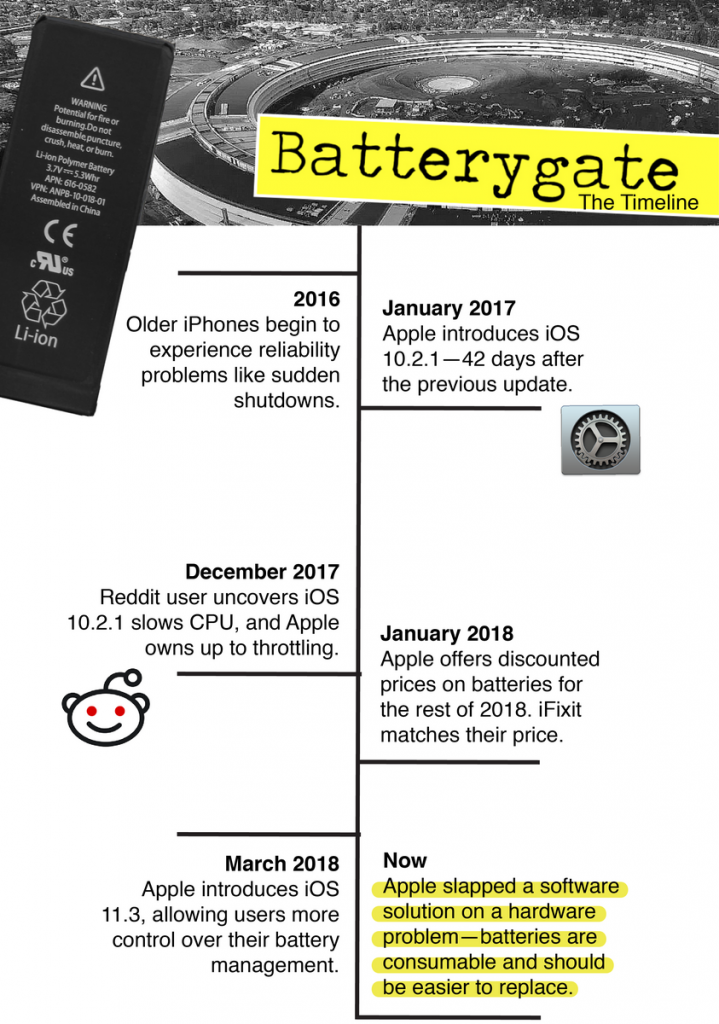In December 2017, after more than a year of reliability issues and speculation, Apple confirmed that they were intentionally slowing iPhone performance in an attempt to prevent phone-crashing power spikes. Essentially, they were applying a software band-aid on a hardware issue.
We called the conflict Batterygate at Wireless World iPhone Repair Claremore.
Fast forward to summer 2018. We’ve already answered your most pressing questions about what caused this issue, but if you’re still a bit lost about how this whole fiasco came to be, here’s a full primer to bring you up to date:
2016
This is when the drama first started. Reports of older iPhones trickled in, citing reliability and usability problems such as sudden shutdowns. In November, Apple announced that this was an issue affecting only a “very small number” of iPhone 6s devices. Whether this was a little white lie or Apple’s ignorance, their “very small” problem proved to be a more widespread issue than initially admitted Wireless World iPhone Repair has confirmed.
January 2017
Apple attempted to resolve the problem—secretly—via iOS update 10.2.1, which made changes to power delivery on all devices newer than the iPhone 6. This feature was obfuscated by a myriad of fixes for security and design bugs that were introduced by iOS 10.2 (released just 42 days prior). Apple remained tight-lipped about the full intent behind the update, but, inevitably, the internet jumped on Apple’s case: Tech journalists and Redditors alike speculated that the update was an attempt to prevent battery shutdowns.
Consequently, this throttling did fix most unexpected shutdowns, but at the hidden cost of reduced performance. Consumers were essentially led to believe that the update, and any resulting performance issues, were the sole solution for their ailing phones. They weren’t told that the software fix was actually limiting battery overexertion, which reduced phone-crashing power spikes, until…
December 2017 (Almost a year later)
A Reddit post breaking down the aging process of Li-ion batteries, followed by research into the CPU of affected iPhones, found that the throttling was, in fact, a battery issue. Replacing the battery in a throttled phone resulted in increased performance, conclusively shining light on Apple’s throttling shenanigans. The phones weren’t the problem—old batteries were. Public outcry and lawsuits ensued. Finally, Apple publicly admitted to CPU throttling for aging batteries.
January 2018
As a way to save face, Apple offered discounted battery replacements for iPhones 6 and newer for the duration of 2018. But there are barely more than 500 Apple stores worldwide, leaving many outside a reasonable coverage area. And for those lucky enough to live near an Apple Store or an Apple Authorized Service Provider, the lines kept getting longer. Wireless World Claremore offered a fix to this problem: matching Apple’s $29.99 repair pricing and doing the iPhone repair in 15 minutes or less.
March 2018
Apple released iOS update 11.3, which provided some much-needed transparency around battery health. And, the legal meetings began for Apple’s 59+ class-action lawsuits that resulted from the scandal.

May 2018
In another attempt to mitigate damage (to their reputation), Apple issued a $50 credit to customers who had paid for an out-of-warranty battery replacement for an iPhone 6 or older device in 2017.
August 2018
Apple asked federal judges to dismiss the lawsuits against them regarding this case. Perhaps misleading consumers about device problems and obfuscating solutions is just normal, legal behavior for the first ever trillion-dollar company. Wireless World iPhone Repair thinks this was just funny legal maneuvering. A joke essentially!
TLDR:
When iPhones with old batteries were not performing up to par—a natural phenomenon for consumables—Apple attempted to secretly slap a software patch on what is essentially a hardware issue. It failed and backfired, so now we’re back to square one: a worn out battery that should be replaced, but is sealed into the phone. Apple shouldn’t be acting surprised when a consumable is used up—it should be providing solutions for that eventuality. Solutions that don’t include making appointments weeks in advance, or traveling hours to an Apple Store when you can come to Wireless World iPhone Repair Claremore and get that same repair performed in less than 15 minutes!
Life after Batterygate
If there was one positive that came out of Batterygate, it was an increased public awareness and support for Right to Repair legislation. That legislation would require device-makers like Apple to give consumers and independent repair shops access to OEM batteries, so that they can easily replace them when they get older. Of course, Apple is still actively leading the fight to make sure that doesn’t happen.
Call us today about our new iPhones with a one-year warranty or schedule your $29.99 iPhone repair online!